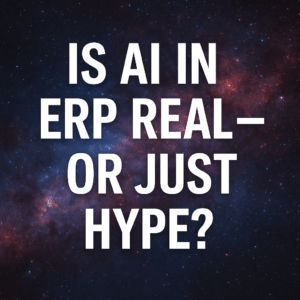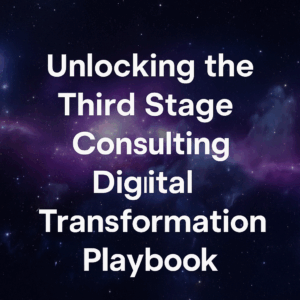As a leader in a digital transformation, your responsibilities go way further than identifying and rolling out new technologies. A digital transformation leader must understand and embrace everything from the company’s business model, processes, people, company culture, and, most importantly, the company’s overarching corporate strategy. They must have a solid grasp on strategy articulation, blooming a digital strategy as a derivative of the corporate strategy as the means to bridge the company’s current and future state.
It’s a lot, I know. But, it’s important.
The reality is that the early decisions you make in a digital transformation project – as well as the early mistakes – will determine whether you see ERP failure or ERP success. Said decisions will be driven by your corporate and digital strategy all the aforementioned factors listed above. Here’s our take on what a digital transformation leader should do to step out on the right path straight out the gate. Let’s start with what digital transformation leaders should not do.
Table of Contents
ToggleWhat digital transformation leaders should not do:
- Contact software vendors or begin the software selection process right off the bat. Yes, we might do research and ask around about the different options available in the marketplace, but to maintain an objective viewpoint, we should never reach out to specific software vendors out the gate. They will get into sales mode, show you how great they can be for your company, and your increase the risk of falling pray to shiny-object-syndrom.
- Contact large system integrators. They’re also regularly biased as a result of their partnerships with software vendors. Their biased and monetized recommendations may not align with your transformation strategy.
What digital transformation leaders should do:
Now to the good part. Digital transformation is driven by a solid strategy that was carefully crafted by the team that understands the foundational roots of who the company is today and who they will be in 5 to 10 years from now. One of the main reasons why digital transformations fail is due to strategic misalignment. Your job as the leader is to bridge the gap by leveraging the right technologies to automate the processes that will get you to that future state. To do this, you need to ensure strategic alignement from an executive level.
- A digital transformation strategy must align with the company’s business strategy. All too often, digital transformations are launched without a clear understanding of how the transformation will enable the company to achieve its business goals. Rather than talking about technology first, we start with understanding the current strategy, what are the company’s vision is, where the growth priorities and operational pain points are, and the company culture we want to create going forward. Get crystal clear on those factors before you dive into software selection and implementation planning.
- In a digital transformation, there’s no one-size-fits-all solution. For example, if one of your goals is to create a common operating platform across multiple locations around the world and have standardized business processes, then we’ll probably consider a single ERP deployment and look at enterprise-wide technology that can create that common operating platform. However, if you’re trying to maximize your flexibility, we would look into point or best-of-breed solutions that allow us to accomplish that strategy.

- This is an operational assessment that considers the strategic alignment and evaluates how your business is operating today, the strengths and weaknesses of those processes, and the obstacles preventing you from providing a better customer or employer experience, among other things.
- What’s your company culture today, and what it should look like in the future? The duration, cost, and risks of your transformation have to do more with your organization’s readiness than with the technology and refer to the indicators that there may be challenges to adapting to change from the cultural consideration’s perspective. This assessment includes an analysis of the company’s culture, processes, and people. We would also look to understand what internal priorities, politics, and even fears may get in the way of a transformation and contribute to the resistance to change.

- The results of the first few steps will determine which direction we look when it comes to software selection. This doesn’t mean looking at specific vendors but at specific types of technologies that align well and can help meet the strategic goals. During the selection process, you will notice that no solution will meet with 100% confidence all the strategic criteria, but you’ll most likely find one that fits who you are as an organization and your strategic goals. Bear in mind that the implementation time, cost, and risks of deploying the different technology options will also influence your decision.
- After you’ve gone through the proceeding points, it’s time to define the roles and responsibilities for everyone involved in the digital transformation process, including your executive committee, project team, SMEs, and any other stakeholders required to make the transformation successful. It also defines how decisions will be made and by who, and how they get escalated, if needed.
Project governance not only provides clarity and alignment but setting this up at an early stage will also provide you with more internal ownership of the project and will ultimately help speed up the process. - It’s important to make a business case for why the digital transformation is necessary and how it will help the company achieve its business goals. Beyond that, a business case can act as the guardrails to your overarching digital transformation project. This process involves identifying and quantifying the business case and communicating it to the entire organization so everyone understands the purpose of the digital transformation and how it will benefit the business’ overall goals and objectives.
Digital transformations are not a walk in the park, but if you have a clear strategy and roadmap, you can set your project for success. If you are considering embarking on a digital transformation journey and would like to learn more about what that might look like for your business, reach out to us and our experts will walk you through the process.





